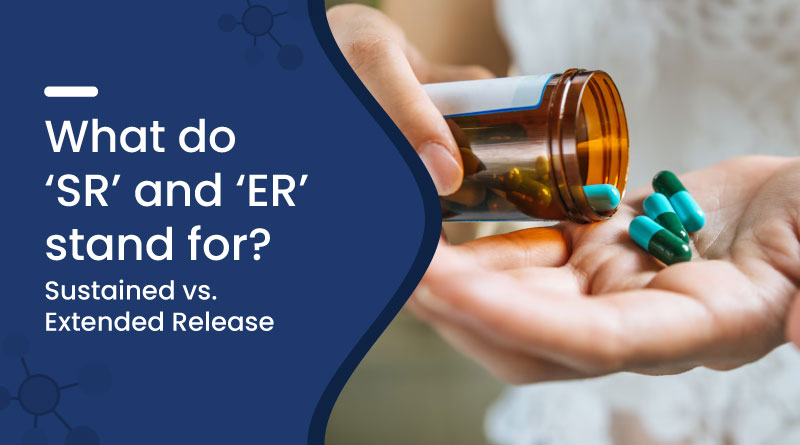What Do ‘SR’ and ‘ER’ Stand for? Sustained vs. Extended Release


When it comes to medications, the terms Sustained Release (SR) and Extended Release (ER) are often used to describe how a drug is released into the body. While these two types of drug formulations may sound similar, they serve distinct purposes. In this blog post, we’ll explore the differences between sustained release and extended release, along with how they work, their benefits, and the key factors to consider when using them.
What is SR (Sustained Release)?
Sustained release (SR) refers to a formulation of a drug that is designed to release the active ingredient gradually over an extended period. This process allows for a steady concentration of the medication in the bloodstream, which can improve its effectiveness and reduce the frequency of dosing. SR formulations are particularly helpful for medications that need to maintain a consistent level in the body for optimal results.
SR medications are usually designed to release the drug over several hours, which can lead to better symptom control and fewer side effects compared to immediate-release versions. Common drugs in SR formulations include pain relievers, antihypertensives, and medications for chronic conditions.
What is ER (Extended Release)?
Extended release (ER) medications also release their active ingredients slowly, but they do so over a longer period than SR formulations. The main difference between ER and SR is the duration of the drug’s release. ER medications are designed to work over an even longer time frame, allowing the drug to be released throughout the day or night. This type of formulation reduces the need for frequent dosing and ensures that the drug’s effects are maintained over a longer duration.
ER medications are typically used for conditions that require constant drug levels in the bloodstream, such as chronic pain management or the treatment of cardiovascular conditions. The primary goal of ER formulations is to provide 24-hour symptom relief with just one or two doses.
Key Differences Between SR and ER
While both SR and ER formulations are designed to control the release of a drug over time, there are some key differences between the two. Let’s break them down:
- Release Duration: SR formulations typically release the drug over a period of a few hours (e.g., 8-12 hours), whereas ER formulations can release the drug over a much longer duration, often up to 24 hours.
- Dosing Frequency: Due to the longer release time, ER medications often require fewer doses—sometimes just once a day—while SR medications may need to be taken two or more times a day.
- Drug Absorption Rate: ER drugs generally have a slower absorption rate, resulting in a more gradual buildup of the drug in the bloodstream. In contrast, SR medications offer a faster yet sustained release.
- Use Cases: SR medications are often used for conditions that require steady levels of the drug, such as arthritis or asthma. ER formulations, however, are used for long-term conditions like chronic pain, depression, and hypertension.
| Feature | Sustained Release (SR) | Extended Release (ER) |
|---|---|---|
| Release Duration | Typically 8-12 hours | Can last up to 24 hours |
| Dosing Frequency | May require 2 or more doses per day | Usually taken once a day |
| Drug Absorption Rate | Gradual release over several hours | Slower, prolonged release over a longer period |
| Use Cases | Conditions requiring steady drug levels (e.g., arthritis, asthma) | Conditions requiring 24-hour relief (e.g., chronic pain, hypertension) |
Why Choose SR or ER Medications?
The decision to use a sustained release or extended release formulation depends on the nature of the condition being treated and the desired outcomes. Here’s why you might choose one over the other:
- SR Medications: SR medications are ideal for conditions where you need a steady level of medication throughout the day. These formulations help prevent the peaks and troughs of drug concentration that can occur with immediate-release medications.
- ER Medications: ER medications are beneficial for conditions that require long-lasting effects throughout the day or night. These drugs are often used in the management of chronic conditions like pain, sleep disorders, and cardiovascular diseases.
Benefits of SR and ER Formulations
Both SR and ER formulations offer several benefits compared to regular immediate-release medications:
- Improved Convenience: With SR and ER medications, you don’t have to take multiple doses throughout the day. This increases patient compliance and makes managing conditions easier.
- Better Symptom Control: These formulations ensure a more consistent level of the drug in your system, leading to better symptom management and fewer fluctuations in effectiveness.
- Reduced Side Effects: By preventing the rapid spikes in drug concentration that can occur with immediate-release versions, SR and ER medications may reduce side effects such as nausea, dizziness, or drowsiness.
How Do SR and ER Medications Work?
The mechanism behind both SR and ER formulations involves altering the way the body absorbs and processes the drug. Both types of medications are designed with special coatings or delivery systems that control the rate at which the active ingredient is released into the bloodstream.
For example, SR medications may have a coating that dissolves slowly in the digestive tract, while ER formulations use specialized matrices or capsules to release the drug in a controlled manner over time. These designs allow for gradual absorption, which provides consistent therapeutic effects over a longer period.
How to Use SR and ER Medications
SR and ER medications should be taken exactly as prescribed by your healthcare provider. Here are some important tips for using them:
- Do not crush or chew SR or ER tablets, as doing so can alter the drug’s release mechanism and may lead to serious side effects.
- Take the medication with food or water as instructed to help with absorption.
- Stick to the prescribed dosing schedule to ensure that the drug works effectively.
Side Effects of SR and ER Medications
Like all medications, SR and ER formulations can cause side effects. Common side effects include:
- Gastrointestinal issues like nausea, constipation, or stomach pain.
- Headaches and dizziness.
- Fatigue or drowsiness.
In rare cases, more severe side effects like liver damage or heart problems may occur. It’s important to discuss any side effects with your doctor and report any unusual symptoms immediately.
Frequently Asked Questions (FAQs)
Q. What is the difference between SR and ER medications?
A. SR medications release the drug over several hours, while ER medications are designed to release the drug over a longer period, usually up to 24 hours.
Q. Can I take SR or ER medications on an empty stomach?
A. It’s important to follow your doctor’s instructions regarding food. Some SR and ER medications may need to be taken with food to avoid stomach irritation.
Q. Can SR and ER medications cause addiction?
A. Most SR and ER medications are not addictive. However, it’s important to follow your doctor’s dosage instructions to avoid misuse.
Conclusion: Choosing the Right Medication
When it comes to choosing between Sustained Release (SR) vs. Extended Release (ER) medications, it’s essential to consider the specific needs of your condition. Both formulations offer significant benefits in terms of convenience, consistent symptom control, and reduced side effects. Always consult your healthcare provider to determine the best treatment plan for your needs.
By understanding the differences between SR and ER medications, you can make more informed decisions about your healthcare and improve your overall treatment experience.
Recent Blogs
Disclaimer : Zeelab Pharmacy provides health information for knowledge only. Do not self-medicate. Always consult a qualified doctor before starting, stopping, or changing any medicine or treatment.
















 Added!
Added!